2015 Kia Soul EV Vs. 2015 Nissan LEAF

Kia did its homework on the Nissan LEAF, mimicking many of the EV’s specifications.
Using an electric motor, the Soul EV makes 109 HP and 210 lb-ft of torque. That’s a slight increase over the LEAF that makes 107 HP and 187 lb-ft of torque. Both vehicles use a single speed transmission and send power to the front wheels. Weighing 3,289 lbs., the Soul is roughly the same weight as a mid-level LEAF SV, although slightly lighter and heavier versions of the Nissan do exist.
SEE ALSO: 2013 Nissan LEAF Review
With a better power-to-torque ratio, the Soul feels quicker off the line. The LEAF doesn’t exactly struggle to build speed, but compared to the Soul, more throttle input is required to get up and moving. Once you reach highway speeds, the LEAF’s superior aerodynamics take over and require less input to maintain momentum. Both vehicles have more than enough power and torque to climb steep hills, but tapping into all the power does hurt efficiency as well as range.
Additional Sophistication
I’ve always been impressed with how easy and smooth the LEAF is to drive, but the Soul EV takes things up a notch. Whatever I’m trying to do with my right foot–accelerate or brake–the Soul responds predictably. Kia has achieved the goal of making the EV drive like a regular Soul, or at least one with much more torque.
T
Batteries, Range and Efficiency
With its larger battery back, the Soul EV takes a little longer to charge. Using a 6.6 kW onboard charger, Kia claims the EV can be recharged in 24 hours using a regular 110v outlet or 4-5 hours with a stage 2 240v charger. The LEAF is also available with 6.6 kW onboard charger (base models use a 3.6 kW charger) that can refill the Nissan with electric goodness in 21 hours using a 110v plug or 5 hours with a less potent 220v stage two charger.
Size and Storage
Although it may be hard to believe, the Nissan LEAF is actually much bigger than the Soul EV. With an overall length of 175 inches, the Nissan is a foot longer than the Kia. The Soul is two-inches taller though and the boxy shape lends itself to the illusion that it is the larger vehicle out of the two.
Compare Specs
| Vehicle | 2015 Kia Soul EV | Advantage | 2015 Nissan Leaf |
|---|---|---|---|
| Engine | Electric Motor | - | Electric Motor |
| Horsepower | 109 HP | Soul EV | 107 HP |
| Torque | 210 lb-ft. | Soul EV | 187 lb-ft. |
| Transmission | Single-Speed | - | Single Speed |
| Battery Size | 27 kW | Soul EV | 24 kW |
| Charge Time | 5 hours (240v) | LEAF | 5 hours (220v) |
| Weight | 3,289 lbs. | - | 3,243-3,328 lbs. |
| Rear Legroom | 36.0-inches | Soul EV | 33.3-inches |
| Cargo Space | 18.8 cubic feet | LEAF | 24.0 cubic feet |
| Fuel Economy (US) | 120 MPGe city, 92 MPGe hwy | LEAF | 126 MPGe city, 101 MPGe hwy |
| Fuel Economy (CDN) | 2.0 L/100 km city, 2.6 L/100 km hwy | LEAF | 1.9 L/100 km city, 2.3 L/100 km hwy |
| Observed Fuel Economy | 98.8 MPGe | LEAF | 107.9 MPGe |
| Single Charge Range | 93 miles | Soul EV | 84 miles |
| Starting Price(US) | $34,525 | LEAF | $29,860 |
| Starting Price(CDN) | $36,710 | LEAF | $33,788 |
| Top Trim Price(US) | $36,525 | Soul EV | $37,935 |
| Top Trim Price(CDN) | $39,710 | Soul EV | $40,838 |
The longer length of the Nissan should lead to a larger interior, but it doesn’t entirely. Both vehicles are engineered with a flat battery pack under the floor to avoid hindering cargo and passenger space. The longer LEAF does hold the storage edge offering 24 cubic feet of space compared to the Soul EV’s 18.8 cubic feet. Fold the rear seats down and the advantage swings back to the Kia with 49.5 cubic feet total space vs. the Nissan’s 30 cubic feet.
Compare Specs
| Vehicle | 2015 Kia Soul EV | Advantage | 2015 Nissan Leaf |
|---|---|---|---|
| Engine | Electric Motor | - | Electric Motor |
| Horsepower | 109 HP | Soul EV | 107 HP |
| Torque | 210 lb-ft. | Soul EV | 187 lb-ft. |
| Transmission | Single-Speed | - | Single Speed |
| Battery Size | 27 kW | Soul EV | 24 kW |
| Charge Time | 5 hours (240v) | LEAF | 5 hours (220v) |
| Weight | 3,289 lbs. | - | 3,243-3,328 lbs. |
| Rear Legroom | 36.0-inches | Soul EV | 33.3-inches |
| Cargo Space | 18.8 cubic feet | LEAF | 24.0 cubic feet |
| Fuel Economy (US) | 120 MPGe city, 92 MPGe hwy | LEAF | 126 MPGe city, 101 MPGe hwy |
| Fuel Economy (CDN) | 2.0 L/100 km city, 2.6 L/100 km hwy | LEAF | 1.9 L/100 km city, 2.3 L/100 km hwy |
| Observed Fuel Economy | 98.8 MPGe | LEAF | 107.9 MPGe |
| Single Charge Range | 93 miles | Soul EV | 84 miles |
| Starting Price(US) | $34,525 | LEAF | $29,860 |
| Starting Price(CDN) | $36,710 | LEAF | $33,788 |
| Top Trim Price(US) | $36,525 | Soul EV | $37,935 |
| Top Trim Price(CDN) | $39,710 | Soul EV | $40,838 |
Comfort and Price
Rear seat passengers will have a better time in the Soul. With a lower placed seat cushion, the Soul offers 39.5-inches of rear headroom that allows six-foot tall adults to fit, while the LEAF’s 37.3 inches of headroom does not. Legroom also favors the Soul EV with an extra 2.7 inches of cramp reducing stretch-out space.
SEE ALSO: Kia Soul EV Heading to Five New States
Pricing for LEAF begins at just $29,860 after destination charges, while the Soul EV carries a much higher $34,525 base price.
The Verdict:
The Nissan LEAF was one of the first vehicles to bring all electric motoring to the masses at a reasonable price. But over the past few years, EVs have evolved at a rapid rate. The Soul EV offers more power, a better passenger experience and higher sophistication. A second generation LEAF should be just around the corner and it will be interesting to see how Nissan responds to well executed competitors like the Kia Soul EV.
2015 Nissan LEAF, 2015 Kia Soul EV
LOVE IT
- More efficient
- Better at highway speeds
- Cargo space
- Good power
- Large backseat
- Sophisticated feel
- Longer range
LEAVE IT
- Feels slower
- Less range
- Small backseat
- Not as refined
- Not as efficient
- Rear seat space
- High entry price

A 20+ year industry veteran, Mike rejoins the AutoGuide team as the Managing Editor. He started his career at a young age working at dealerships, car rentals, and used car advertisers. He then found his true passion, automotive writing. After contributing to multiple websites for several years, he spent the next six years working at the head office of an automotive OEM, before returning back to the field he loves. He is a member of the Automobile Journalists Association of Canada (AJAC), and Midwest Automotive Media Association (MAMA). He's the recipient of a feature writing of the year award and multiple video of the year awards.
More by Mike Schlee



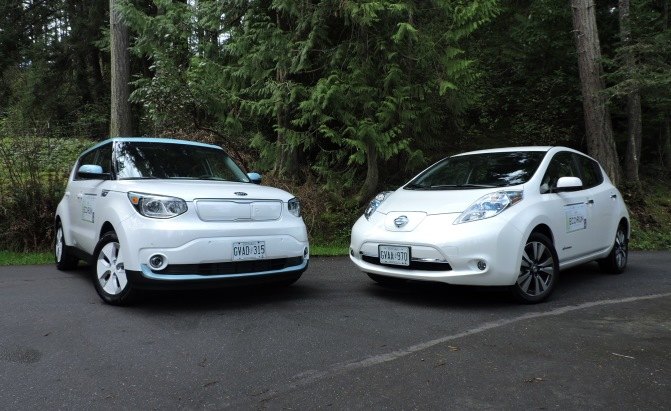





















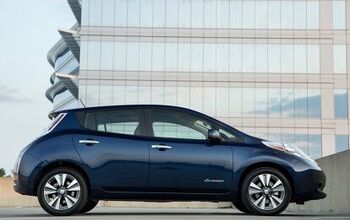
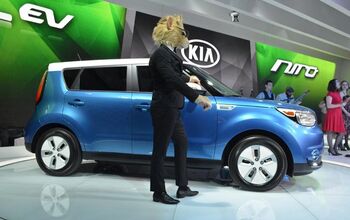





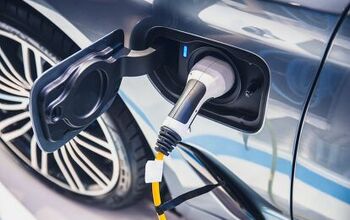



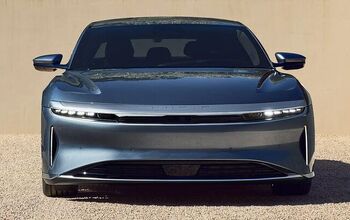


Comments
Join the conversation
Why does the Soul have the rear seats as both a pro and a con?
The comparison is fine for those purchasing or leasing a new vehicle, however, if you compare the price of purchasing a 2011 Kia Soul EV to a 2011 Leaf...oh wait, you can't. Nor can you compare a 2012, 2013 or 2014 since the Soul ev did not come out until 2015 (o.k., technically it came out in very late 2014 I suppose). Point being, I purchased a 2013 Nissan Leaf SV with QC for under $12k. I could not do that with a Kia as there was really no other comparison. At least for my next ev (that will also be purchased two or three years used), I will have some options.